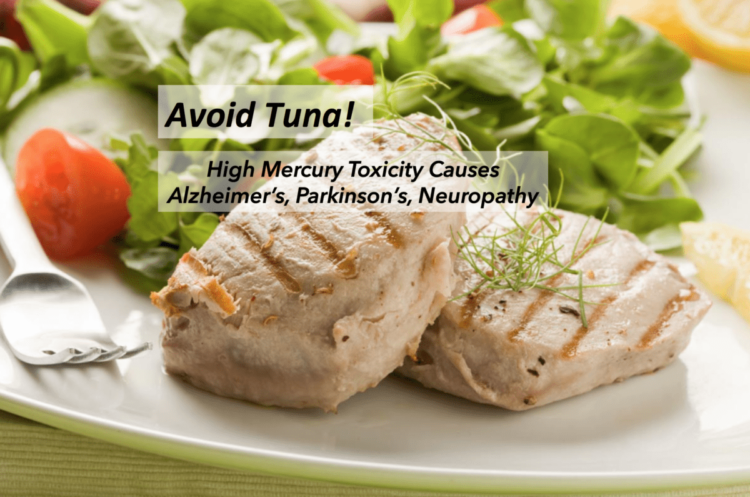Bad news! Tuna is by far the largest source of mercury exposure in our diet. Mercury bio-accumulates for years in the body, therefore it’s especially dangerous for children. Mercury is linked to Alzheimer’s, Parkinson’s and Neuropathy. Your healthy solution: Wild Alaskan Salmon is probably the best fish you can eat that has the lowest levels of heavy metals.
Mislabeling found in 59% of Tuna samples – By Dr. Mercola
Oceana conducted DNA testing on more than 1,200 fish samples across the US and found that one-third were mislabeled. While red snapper had the highest mislabeling rates (87 percent of ‘red snapper’ samples were not actually red snapper), tuna was a close second, with 59 percent mislabeled.
At sushi restaurants, however, 74 percent of fish samples were mislabeled. This included every single sushi restaurant from which samples were tested, even in major metropolitan areas like Chicago, Austin, New York and Washington DC.
According to Oceana’s 69-page report,2 in many cases the mislabeled fish had been substituted for cheaper, less desirable and/or more readily available fish varieties. The results showed that:
- Mislabeling was found in 27 of the 46 fish types tested (59 percent)
- 87 percent of fish sold as snapper was actually some other type of fish
- 59 percent of tuna was some other type of fish
- 84 percent of “white tuna” sold in sushi venues was actually escolar, a fish associated with acute and serious digestive effects if you eat just a couple of ounces
How much tuna are you eating, and how much should you eat? As you may know, tuna has a certain level of mercury in it. Mercury is a toxic metal that can cause a variety of symptoms depending on what your body’s mercury level is. Extreme exposure can cause severe cognitive decline and dementia. Here’s a little trivia for you: In the old days, mercury was used in the manufacture of the brims of hats. Because “hatters” were exposed to such high levels, they frequently would find themselves in a demented state later in life, hence the term “Mad Hatter”. In lower body mercury levels, other nerve system damage can cause numbness, tingling, fatigue and other “I just don’t feel right” symptoms.
Too Much Tuna? What does DR. ANDREW WEIL, M.D. say?
Q: I heard that college kids are eating a lot of tuna these days and as a result are ingesting too much mercury. Is there a health risk? How much tuna is too much?
A: As you may know, tuna and other large fish including shark, swordfish, king mackerel and tilefish contain significant amounts of toxic methylmercury. Exposure to high levels of this form of the heavy metal can cause neurological damage. Mercury gets into the oceans from natural sources as well as from emissions of coal-fueled power plants.
A professor at the University of California, Santa Cruz became concerned about the amounts of tuna her students were eating. Together with a team of researchers, she conducted a survey among the undergraduates and also measured mercury levels in hair samples the students provided. Half of those who ate tuna reported consuming it three or more times a week, exposing them potentially to doses of methylmercury exceeding those deemed safe by the Environmental Protection Agency (EPA). Worse, seven percent said they consumed more than 20 tuna servings weekly. Not surprisingly, mercury was found in the hair samples. Levels were about 10 times the amount found in those who didn’t consume tuna.
Most of the students’ meals came from campus dining halls where tuna is regularly available at salad bars. Analysis of the mercury content of that tuna showed that it varied widely from month to month with some samples having five times more mercury than others.
Because of its effects on neurological development and reproductive health, mercury exposure is more dangerous for pregnant women and children. But college students and other young people may be at risk, too. Study leader Myra Finkelstein, an associate adjunct professor of environmental toxicology, advised students to limit their exposure to mercury because their nervous systems are still developing, and they are of reproductive age. Nearly all fish contain some mercury, but tuna – especially larger ones – accumulate relatively high levels.
You get less methylmercury (0.12 parts per million) in canned light tuna and more (0.32 parts per million) in canned white (albacore) tuna. Adults can safely eat canned light tuna once a week and six-ounce portions of canned white or albacore tuna up to three times a month.
If you’re concerned about mercury accumulation as a result of your fish consumption, you can get your blood level of it tested, but be aware that a high test result may have little or no clinical significance in adults. You can lower your mercury level over time by simply not eating fish most likely to contain a lot of it. Here’s a link to the FDA’s list of fish that does and doesn’t contain mercury.
Andrew Weil, M.D.
Source:
Yasuhiko Murata and Myra E. Finkelstein et al, “Tuna consumption, mercury exposure, and knowledge about mercury exposure risk from tuna consumption in university students.” Environmental Toxicology and Chemistry, June 12, 2019; DOI: 10.1002/etc.4513





2 Replies to "Avoid Tuna, Mercury & Alzheimer's Risk"
Steve March 28, 2023 (1:10 pm)
In the second to last paragraph above, you say a 145 pound woman can safely eat 13.2 ounces of tuna a week. Then you say the same woman can safely eat only 4.5 ounces of tuna a week. In the second sentence did you mean “Albacore tuna”?
Jane Barthelemy March 31, 2023 (11:42 pm)
Hi Steve,
Thank you for your astute comment. You’re right. This is very confusing. And it turns out the doctor’s link is no longer active. I just deleted the confusing passage and changed the post to add Dr. Andrew Weil’s comments on tuna. Thank you again! Jane